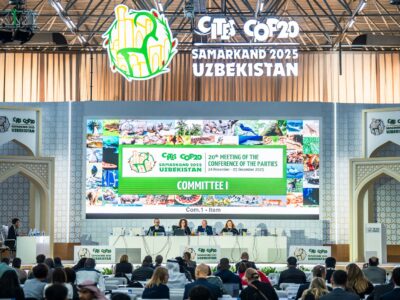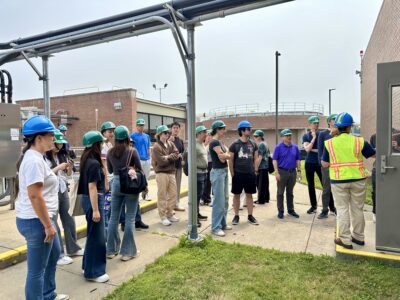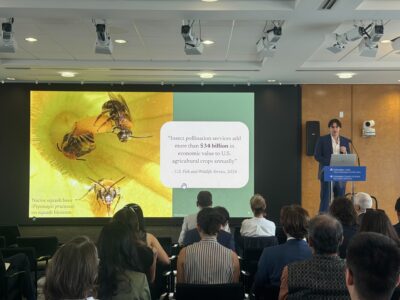This past summer, students from Columbia’s Master of Public Administration in Environmental Science and Policy (MPA-ESP) program participated in an Urban Ecology field trip led by Matthew Palmer, senior lecturer in the department of Ecology, Evolution and Environmental Biology at Columbia. The cohort visited three key sites in New York City—Randall’s Island, River Park and Bronx Park East—each serving as a living laboratory where students explored the intersection of natural ecosystems and urban environments. Through hands-on learning and direct observation, students deepened their understanding of the vital role urban ecology plays in fostering sustainable and resilient communities.
First Stop: Randall’s Island

The journey began at Randall’s Island, where students met Anne Wilson, chief director of planning at Randall’s Island Park Alliance (RIPA). Wilson explained how RIPA, a nonprofit public-private partnership established in 1998, manages the park by securing both private and public funds. This approach allows RIPA to enhance the park efficiently, supporting features like waterfront pathways, courts and fields that draw nearly four million visitors annually.

Next, Olivia Smith, a biologist with RIPA, discussed Little Hell Gate Salt Marsh, one of the first restored salt marshes in New York County. The marsh, named for its treacherous waters that once caused shipwrecks, supports a higher rate of plant and animal growth per square foot than even rain forests, making it a vital nursery for fish. Its tall spartina grasses filter sediments and “sweat” salt, while mussels contribute to nutrient cycling. However, the marsh’s limited space for migration and small size leave it vulnerable to frequent hurricanes, highlighting the need for additional restoration efforts. On the island, restoration primarily focuses on plant management, as animals naturally migrate to these renewed habitats.
Palmer provided students with an overview of Randall’s Island’s hydrological challenges and restoration efforts. Originally two small islands surrounded by salt marshes, Randall’s Island has undergone significant changes due to urbanization, leading to altered stream flows and issues with shallow groundwater discharge. To address these, nature-based solutions like wetland construction have been implemented, which help manage stormwater and improve water quality. Most rainwater on the island is now collected in pipes designed to filter out trash and slow sediment deposition, with the island’s topography and soil microbes playing a key role in treating the stormwater. Heavy metals, while not broken down, are immobilized in the soil and absorbed by plants, while hydrocarbons are broken down by microbes.
Second Stop: River Park

At River Park in the Bronx, the cohort learned about the wetland restoration efforts led by the Natural Resources Group team from NYC Parks. The Bronx River, influenced by tides near its southern end, supports a dynamic ecosystem, including oysters that filter water and create habitats for marine life. However, poor water quality and excessive sediment hinder the growth of oyster reefs. The Billion Oyster Project addresses this by collecting oyster shells from restaurants and depositing them in the river to provide a hard substrate for reef formation.
Students also explored the role of anadromous fish like river herring, which swim upstream to breed. A dam, initially built in the 1600s, blocked herring migration for centuries. However, the construction of a fish ladder and the introduction of herring from other locations to the Upper Bronx River have helped restore their breeding patterns. The herring imprint on the chemical composition of the river during their early life stages, which allows them to recognize and return to the same location to spawn as adults.

The discussion then shifted to green infrastructure in the Bronx. Students learned how rooftops and impervious surfaces contribute to rapid water flow into sewers, leading to pollution and potential fines for New York City. The city is currently investing in green infrastructure solutions, such as green roofs, bioswales and rain gardens to help absorb stormwater, reduce sewage overflow and promote groundwater recharge.
Final Stop: Bronx Park East

The final stop was Bronx Park East, where Ayanna Butler, an urban ecology teaching assistant, discussed the connection between streams and forest health. She explained how hurricanes can cause significant nitrate loss from forests, impacting the nitrogen cycle—a critical process for both plant and animal life. Butler detailed the processes of mineralization, nitrification and nitrogen fixation, particularly highlighting the role of black locust trees in converting atmospheric nitrogen into a form usable by plants.

In Bronx Park East, students also learned about the challenges of managing invasive species, with a focus on knotweed. Originally introduced as an ornamental plant, knotweed has become one of the most aggressive invasive species in urban environments. Its rapid growth allows it to form dense thickets that outcompete native vegetation, reducing biodiversity and threatening local wildlife. Additionally, these dense thickets can obstruct visibility, creating secluded areas that may attract undesirable activities—a concern even for law enforcement. Knotweed thrives in disturbed soils common in urban settings, making it particularly difficult to control. Its shallow root system also makes it less effective at stabilizing soil, which can exacerbate erosion in floodplain areas. However, natural shading from taller trees and plants has proven to be an effective method for suppressing its growth. By reducing the amount of sunlight that reaches the ground, native tree cover can help limit the spread of knotweed, offering a more sustainable approach to managing this persistent invader.
Together, these three stops provided Columbia’s MPA-ESP students with an invaluable hands-on experience, demonstrating the complex balance needed to maintain and restore natural environments within a dynamic urban setting. From the restoration efforts on Randall’s Island’s salt marshes, to the role of oysters and green infrastructure along the Bronx River and the critical connections between forest health and urban streams in Bronx Park East, students were able to directly connect their classroom knowledge to real-world environmental challenges.



